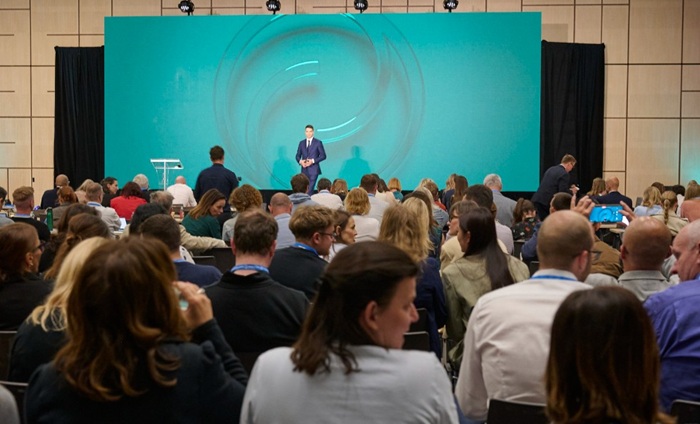Trust is becoming increasingly important in today's world and has a direct impact on a company's business results. One example is Tesla, which saw its sales fall by 13 per cent to 336,681 vehicles in the first quarter of this year alone, largely due to the carmaker's CEO Elon Musk and his political involvement, which is negatively affecting the brand's credibility. The topic of trust was discussed at length at the Communication Summit conference organised last week by Blue Events.
Consistency is essential for building brand credibility
Andrew Tindall from the agency System1 spoke about the increasingly important influence of trust on business results. Since 2000, brand trustworthiness has had a much greater impact on business profits, and it is clear that trustworthy brands are growing faster.
According to Tindall, brand trust can be built positively through the selection of media in which it communicates, using ‘fluency’ and consistency of communication. Brand position in search results, display advertising, radio, print and television can all contribute to trustworthiness. Social media and video content, on the other hand, are not as helpful.
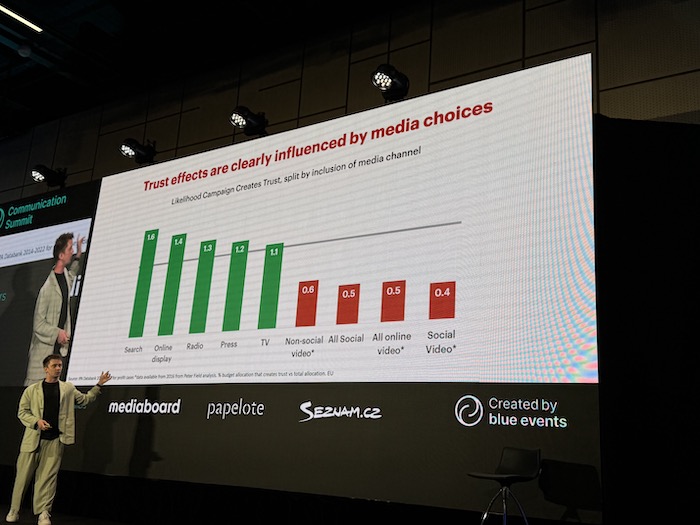 Trust is also influenced by the selected media types; Source: MediaGuru
Trust is also influenced by the selected media types; Source: MediaGuruFluency measures the strength of branding in advertising and is determined by the accuracy and speed of brand recognition. Radio advertising scores very well in this respect. Brands with above-average fluency in radio spots enjoy twice as much trust as brands with low fluency.
Consistency of communication is also crucial for brand trustworthiness. This consists of creative foundations that ensure consistent positioning and long-term work with creative ideas and agencies. It appears that companies benefit more from marketing if they change creative agencies less frequently, but the opposite is true for marketers – in companies where there is no staff turnover, marketing activities achieve weaker results.
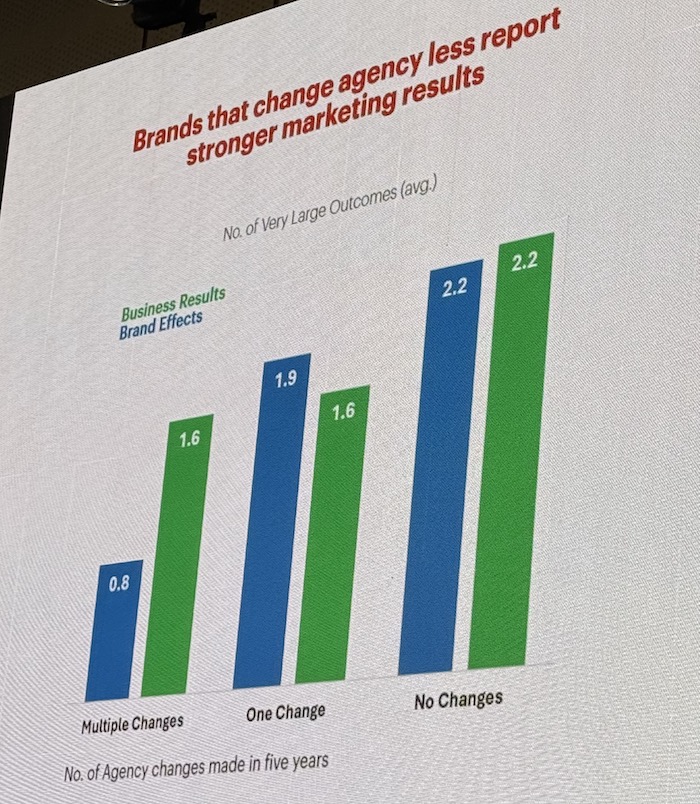 Frequent agency changes do not have a positive effect on marketing results; Source: MediaGuru
Frequent agency changes do not have a positive effect on marketing results; Source: MediaGuru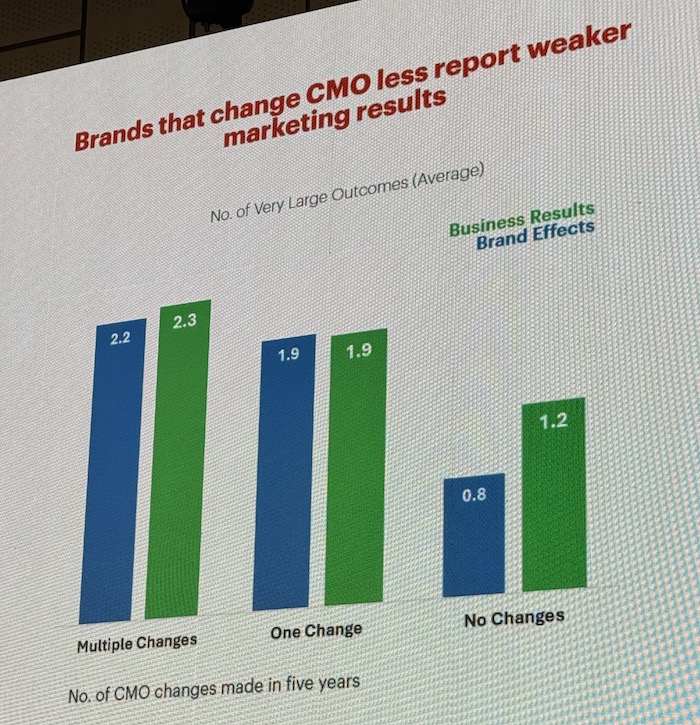 On the contrary, personnel changes in the CMO position can benefit marketing results; Source: MediaGuru
On the contrary, personnel changes in the CMO position can benefit marketing results; Source: MediaGuruConsistency is also about coherence in communication. It is essential that a brand is consistent across media channels, is not afraid to let its advertising campaigns run for a longer period of time and is able to entertain its audience. Last but not least, it also depends on the actual execution, which should skilfully work with the individual brand codes. Consistently managed brands grow faster. ‘The most consistent ones have up to 4.8 times greater brand effect,’ added Tindall.
Readers' trust is the most important asset of the media
Robert Čásenský, who has been editor-in-chief of Seznam Zprávy since January, focused on media credibility. "Building trust is like building the Eiffel Tower out of matches. It is a long and laborious process, and the results can collapse very quickly," he said, pointing out that it does not pay for the media to rely entirely on artificial intelligence, which does not verify stories but creates them itself.
‘It can't be done without people, but it can't be done without machines either,’ said Čásenský, noting that Seznam publishes 3,000 articles a day, of which about two-thirds come from external sources. Seznam Newsfeed features articles from 420 websites, which have been evaluated by automated systems for several years. Last year, the machines processed 610,662 published articles, of which 37,526 were evaluated as having a higher clickbait score and were subsequently sent for review or rejected.
According to Čásenský, trust is one of the most important assets of any media outlet. ‘Failure can never be ruled out, but it can be prevented by taking certain steps and following certain procedures,’ he advised. It is essential that article authors are knowledgeable about the topic, because readers will quickly see through ‘hot air.’ It is also necessary to verify information, check outputs and ensure the accuracy of headlines, which should not deviate from the content of the article. ‘Clickbait is one of the poisons of Czech journalism, and it's easy to get used to, but none of us want to feel repeatedly deceived,’ said Čásenský.
It is also necessary for the media to maintain an unbiased approach to information and not decide in advance ‘who is the villain and who is the hero’. All sides of the story must be given space and each version must be verified. "All sources must be approached critically. We have a rule that either the editor-in-chief or the section editor must know all the sources used in an article. We don't want to be used by someone we don't know, or for unclear purposes," revealed Čásenský, adding that the world must be described as it is, not as we would like it to be, even if this is sometimes difficult.
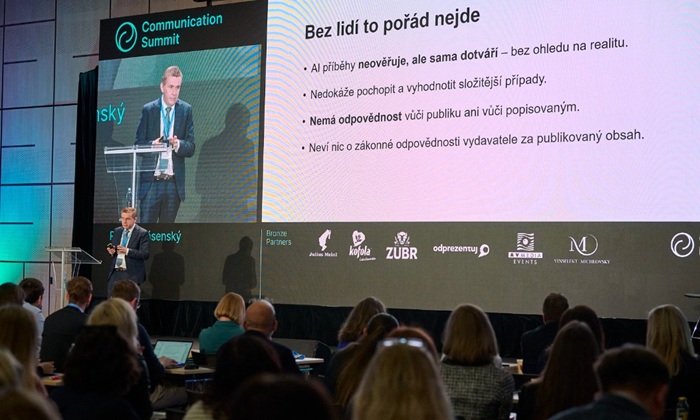 Robert Čásenský at the Communication Summit 2025 conference, source: Blue Events
Robert Čásenský at the Communication Summit 2025 conference, source: Blue EventsTrust needs to be thought of as capital
Rostislav Starý from the agency Konektor believes that trust is measurable. ‘We should talk about it as capital, because it helps the PR industry to be understood within the company,’ he said, adding that one way to do this is through a measure called reputation capital, which describes the trust, credibility and social legitimacy of a brand over time.
Reputation capital is composed of several measurable criteria. First is brand visibility, its mental availability, consistency and the sentiment it evokes. This can be measured using media analysis. Second is trust in leadership, i.e. how visible, consistent, understandable and likeable the management of a given company is. Up to 82% of respondents are more likely to trust a company if its CEO and management communicate on social media, which can again be measured by media analysis or social media monitoring, especially LinkedIn. Thirdly, there is customer experience, which can be tracked through NPS or customer reviews. Fourthly, third parties such as partners, associations, experts, ambassadors or various awards and certificates also play an important role in building trust. And fifthly, the influence of employer branding and internal trust is growing, which can be measured through satisfaction surveys or external tools such as Atmoskop or Glassdoor.
 Elements of reputation capital in Rostislav Starý's presentation at the Communication Summit 2025 conference; Source: Blue Events
Elements of reputation capital in Rostislav Starý's presentation at the Communication Summit 2025 conference; Source: Blue EventsThe irreplaceable role of reputation is also demonstrated by the fact that consumers prefer to buy products whose brand has a better reputation, even if they are 20% more expensive. Moreover, a company's reputation as a good employer is more important to more people (86%) than career growth opportunities.
Behavioural approaches also contribute to trust
Sebastian Salomon-Ballada and Tu Vy Do from the Behavioural Insights Team explained how behavioural psychology can be used to strengthen credibility in communication. The EAST method, or four behavioural approaches, can help with this. It emphasises simplicity, attractiveness, social dimension and good timing (Make it Easy, Attractive, Social and Timely).
The message must be simple and easy to read for the audience, without specific jargon, and with key information clearly highlighted. Visualisation and interactive design, or adaptation to the target group, also aid understanding. It is also necessary to add a clear call-to-action, i.e. instructions on what to do next.
Emotions and framing, which bring the message closer to the recipient, contribute to attractiveness. It pays to show the pros and cons, tell stories or answer frequently asked questions. The social dimension of the message is provided by a third party – trusted personalities, good practice cases, recommendations from others or examples of new approaches and their impact. And for good timing, it is good if the message helps the audience to plan, presenting them with an action plan and the individual steps that lead to the goal. A clear deadline or time pressure inspires immediate response, while reminders also help.
Source: mediaguru.cz

